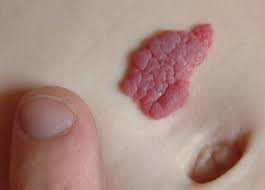Definisi
Meningioma adalah istilah yang digunakan untuk tumor yang terbentuk pada selaput meninges, atau selaput yang melindungi otak dan tulang belakang. Tumor ini biasanya tumbuh secara perlahan, kebanyakan bersifat jinak dan tidak memerlukan perawatan yang segera. Namun, tidak menutup kemungkinan tumor ini dapat berkembang menjadi tumor yang ganas dan bersifat seperti kanker yang menyebar ke organ lain seperti pada beberapa kasus. Meningioma adalah jenis tumor di kepala yang paling sering terjadi.
Meningioma berasal dari sel-sel arachnoid cap, yaitu sel-sel pembentuk selaput tipis seperti jaring laba-laba yang menutupi otak dan sumsum tulang belakang. Arachnoid sendiri merupakan salah satu dari tiga bagian lapisan selaput yang melindungi otak dan tulang belakang.
Berdasarkan keganasannya, meningioma terbagi dalam tiga keparahan:
- Grade 1 atau tipikal
Ini adalah meningioma yang jinak dan tumbuh secara perlahan. Tumor tipikal ini muncul pada 80% kasus meningioma.
- Grade 2 atau atipikal
Meningioma non kanker yang tumbuh lebih cepat, namun masih responsif terhadap perawatan bila ditangani segera. Meningioma atipikal muncul pada 17% dari keseluruhan kasus.
- Grade 3 atau anaplastik
Tipe ini adalah tipe meningioma ganas (kanker) yang tumbuh dan menyebar dengan cepat. Meningioma anaplastik muncul pada 1,7% dari keseluruhan kasus.
Penyebab
Penyebab pasti dari meningioma masih belum diketahui, namun dari beberapa penelitian didapatkan teori bahwa kelainan kromosom berperan dalam menyebabkan timbulnya meningioma. Kelainan kromosom bisa membuat pembelahan sel arachnoid menjadi berlebihan, sehingga lama-lama berkembang menjadi tumor. Yang jelas, beberapa faktor risiko sudah terbukti berpengaruh terhadap perkembangan meningioma.
Faktor risiko
Meningioma memiliki beberapa faktor risiko yang diduga membuat seseorang memiliki kemungkinan lebih tinggi untuk terkena penyakit meningioma, dimulai dari:
- Jenis kelamin wanita
- Usia 70–80 tahun
- Riwayat pengobatan radioterapi sebelumnya
- Riwayat penyakit saraf pribadi atau pada anggota keluarga lain
- Riwayat penyakit genetik langka di keluarga seperti neurofibromatosis tipe 2 (kondisi genetik atau bawaan lahir yang membuat tumor jinak bisa tumbuh di sepanjang serat saraf)
- Obesitas
- Ras atau etnis tertentu seperti etnis Afrika
Gejala
Karena tumbuh secara perlahan dan memerlukan waktu bertahun-tahun, terkadang kasus meningioma tidak menimbulkan gejala. Pada beberapa kasus, tumor akan menimbulkan gejala bila sudah berukuran cukup besar di otak. Meningioma bisa menimbulkan gejala–gejala seperti di bawah ini, yaitu;
- Sakit kepala
- Kejang
- Pandangan kabur
- Pandangan ganda
- Kelemahan anggta gerak pada lengan atau kaki
- Penurunan sensasi sensorik atau terasa baal pada kulit
- Hilang keseimbangan
- Hilang memori
- Hilang pendengaran
Diagnosis
Seperti penyakit lainnya, dokter akan melakukan wawancara, pemeriksaan fisik, dan pemeriksaan penunjang pada pasien untuk membantu menegakkan diagnosis.
Wawancara Medis
Wawancara akan dilakukan untuk menggali keluhan pasien lebih dalam. Selain itu, dokter juga akan menanyakan:
- Riwayat penyakit terdahulu
- Riwayat penyakit keluarga
- Riwayat pengobatan yang mungkin pernah dialami
Hasil wawancara tersebut akan dilihat apakah sesuai dengan gejala dari penyakit meningioma.
Pemeriksaan Fisik
Pemeriksaan fisik dilakukan untuk memeriksa fungsi saraf dari pasien. Dokter akan melakukan berbagai pemeriksaan fisik seperti pemeriksaan keseimbangan, pemeriksaan penglihatan mata, pemeriksaan refleks pasien, pemeriksaan saraf wajah, pemeriksaan saraf anggota gerak, dan pemeriksaan sensoris guna mengetahui apakah ada fungsi saraf yang terganggu.
Pemeriksaan Penunjang
Sedangkan, pemeriksaan penunjang akan dilakukan untuk mengonfirmasi letak, ukuran, dan seberapa bahaya tumor. Pemeriksaan yang dapat dilakukan yakni pemeriksaan Computed Tomography (CT – Scan) dan Magnetic Resonancy Imaging (MRI). Dokter akan memilih jenis pemeriksaan yang sesuai dan tersedia di fasilitas kesehatan anda.
Selain pemeriksaan tersebut, pemeriksaan patologis yakni pengambilan sel tumor juga mungkin dilakukan guna memeriksa tumor di bawah mikroskop. Mengetahui jenis dan tingkat keganasan tumor dapat membantu memilih jenis terapi yang diperlukan pasien.
Tata Laksana
Tata laksana meningioma akan bergantung dengan berbagai faktor, termasuk:
- Lokasi dari tumor
- Jenis tumor apakah tumor tersebut ganas atau jinak, ukuran
- Preferensi pasien terhadap opsi pengobatan
Operasi
Operasi terbuka tetap akan menjadi tata laksana utama, selain untuk mengambil tumor secara total, pengambilan tumor juga dapat berguna untuk dilakukan pemeriksaan patologis dibawah mikroskop apakah tumor tersebut jinak atau ganas.
Observasi
Observasi berarti dokter akan melakukan pemeriksaan pencitraan (MRI, CT Scan) secara periodik guna melihat perkembangan tumor dari waktu ke waktu. Ada beberapa kasus meningioma yang tidak menimbulkan gejala sama sekali dan pengobatan mungkin dilakukan hanya bila selama periode observasi ditemukan gejala yang berkembang atau ukuran tumor membesar dan memburuk.
Tindakan pembedahan
Tindakan pembedahan yang paling sering dilakukan untuk menghilangkan meningioma adalah kraniotomi. Prosedur ini dilakukan dengan membuat sayatan di kulit kepala dan memindahkan sebagian kecil tulang tengkorak. Setelah itu, dokter bedah saraf akan mendapat akses ke dalam kepala dan mengangkat jaringan tumor dengan hati-hati.
Radioterapi
Radioterapi adalah pengobatan tumor menggunakan sinar x dan bentuk lain dari radiasi. Diharapkan sel kanker hancur atau tumor tidak tumbuh dan berkembang. Radioterapi dapat digunakan untuk mengobati meningioma yang dari lokasinya dianggap terlalu berbahaya untuk dilakukan operasi terbuka. Contohnya, bila tumor berdekatan dengan pembuluh darah.
Terapi rehabilitasi
Terapi rehabilitasi akan dibutuhkan untuk pasien setelah tindakan, baik itu tindakan operasi atau radioterapi. Terapi ini bertujuan untuk mengembalikan pasien agar tubuhnya dapat berfungsi seperti sedia kala. Misal, untuk pasien dengan keluhan kelemahan anggota gerak, maka akan dilakukan terapi rehabilitasi agar pasien dapat kembali melakukan aktivitas dan bergerak seperti sedia kala secara perlahan. Terapi bicara juga mungkin dibutuhkan untuk pasien yang memiliki kesulitan berbahasa akibat meningioma.
Komplikasi
Layaknya penyakit lain, selalu ada komplikasi dari penyakit termasuk meningioma. Terkadang, komplikasi muncul dari penyakit itu sendiri atau dari pengobatan yang dilakukan. Beberapa komplikasi dari meningioma antara lain:
- Kesulitan untuk fokus
- Penurunan memori
- Perubahan kepribadian
- Kelemahan di lengan atau kaki
- Sulit memahami suatu bahasa
- Kejang
Pencegahan
Karena penyebab pastinya yang masih tidak diketahui, maka tidak ada cara pasti untuk mencegah meningioma. Namun, selayaknya penyakit lain, beberapa hal dapat dilakukan untuk tetap mengurangi risiko terkena meningioma, yakni:
Melakukan pola hidup sehat
Hindari merokok, konsumsi alkohol, dan makanan cepat saji secara berlebihan. Konsumsi makanan dengan gizi seimbang dan cukupi asupan cairan yang dibutuhkan tubuh.
Hindari obesitas
Obesitas merupakan kunci dari seluruh penyakit. Maka dari itu, dengan menghindari obesitas dan menjaga berat badan yang ideal, maka risiko untuk terkena penyakit apapun termasuk tumor dan kanker akan berkurang.
Hindari paparan radiasi bila tidak diperlukan
Paparan radiasi yang tidak perlu dapat mengurangi sel dalam tubuh untuk membelah diri, termasuk sel–sel kanker.
Hindari stres
Stres yang berlebih tentunya tidak baik dan berdampak dalam perkembangan suatu penyakit dalam tubuh.
Kapan Harus ke Dokter?
Karena kebanyakan kasus meningioma tumbuh secara perlahan, maka jarang sekali pasien meningioma membutuhkan perawatan ke instalasi gawat darurat. Namun, segera cari bantuan medis bila Anda mengalami salah satu tanda kegawatan saraf berikut seperti:
- Nyeri kepala hebat
- Mual muntah
- Pandangan kabur atau ganda yang timbul mendadak
- Kelemahan anggota gerak
- Kejang
- Penurunan kesadaran.
Dokter di instalasi gawat darurat akan melakukan pemeriksaan lengkap dan memastikan bahwa gejala tersebut muncul akibat meningioma atau akibat penyakit saraf lainnya.
Mau tahu informasi seputar penyakit lainnya? Cek di sini, ya!
- dr Hanifa Rahma
American Association of Neurological Surgeons - Meningiomas (2020). Retrieved 20 July 2022, from https://www.aans.org/Patients/Neurosurgical-Conditions-and-Treatments/Meningiomas
John Hopkins Medicine - Brain Tumors (2020). Retrieved 20 July 2022, from https://www.hopkinsmedicine.org/brain-tumor/specialty-centers/meningioma/treatment.html
Mayoclinic - Meningioma (2019). Retrieved 20 July 2022, from https://www.mayoclinic.org/diseases-conditions/meningioma/symptoms-causes/syc-20355643
Verywell Health - Meningioma (2021). Retrieved 20 July 2022 from https://www.verywellhealth.com/meningioma-signs-symptoms-and-complications-5199404












